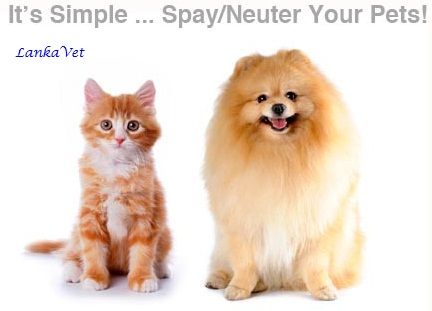Spaying is a general term used to describe the
ovario-hysterectomy of a female animal whereas Neutering is used to describe the
castration of a male animal. However, neutering is often used in reference to
both genders. The surgical procedure, performed by a veterinarian, renders the
animal incapable of reproducing. Here are answers to some questions you may
have about this beneficial procedure.
]
When can you have this procedure done?
Both procedures can safely be performed at as early as 3 months
of age.

Why should you have your pet neutered?
Animal shelters, both public and private, are faced with an
incredible burden in overpopulation of dogs and cats that they cannot find
homes. Having your pet spayed or neutered ensures that you will not be adding
to this tremendous burden.
What are some of the health and behavioral benefits?
Through neutering, you can help your dog or cat live a happier,
healthier, longer life. Spaying eliminates the constant crying and nervous
pacing of a female cat in heat. Spaying a female dog also eliminates the
messiness associated with the heat cycle.
Neutering of male dogs and cats can prevent certain undesirable
sexual behaviors, such as urine marking, humping, male aggression and the urge
to roam. If you have more than one pet in your household, all the pets will
generally get along better if they are neutered.
A long-term benefit of spaying and neutering is improved health
for both cats and dogs. Spaying females prior to their first heat cycle nearly
eliminates the risk of breast cancer and totally prevents uterine infections
and uterine cancer. Neutering males prevents testicular cancer and enlargement
of the prostate gland, and greatly reduces their risk for perianal tumors.
Neutering just costs too much!
The cost of caring for a pet, including providing veterinary
care, should be considered before acquiring an animal. Many animal shelters
offer low-cost spay/neuter services, and there are also many low-cost
spay/neuter clinics across the country. The reality is that the cost associated
with providing adequate care for just one litter of puppies or kittens is often
more than the cost of spaying or neutering. You must also consider that there
could be complications with the birth that require hospitalization or surgery.
You will also be faced with finding good homes for the offspring yourself or
placing more animals into your local shelter. The cost of the well-being of not
just your companion animal, but of future generations, should be considered.
What is this problem?
All of us are affected by animal overpopulation. Human health is
threatened by the danger of transmittable diseases (including rabies), animal
bites and attacks. Property may be damaged and livestock killed when pets roam
in search of food. Animal waste is proving to be a serious environment hazard,
fouling yards and parks. It is only when all of us assume the responsibility
for pet overpopulation that we will see any decrease in the problem.


No comments:
Post a Comment